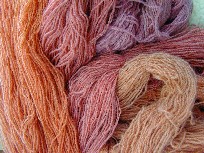| Creating Color in Yarn: An Introduction to Natural Dyes Try naming two colors that occur in nature and clash when next to each other. Chances are, you can't. Re-creating these colors in fiber isn't just a matter of tossing a batch of strawberries and yarn in a big pot of boiling water. Colors to Dye For Once you begin to experiment with dyes, you'll discover an entire other world of creative freedom. You can try dyeing your own handspuns or simply use a commercially spun white yarn. You can even experiment by dyeing already colored yarns in your stash -- a process known as "overdyeing." Chemical or Natural? There are two schools of thought where fiber dyeing is concerned: chemical or natural. As is the case with most chemical vs. natural processes, chemical dyeing is generally regarded as easier with more consistent, durable results. However, chemical dyeing involves using toxic ingredients that aren't always good for the environment or for the person doing the dyeing. A renewed interest in natural dyeing has resulted in several new natural dye companies that offer more reliable and durable colors. The Mordant Merrier Both natural and chemical dyes depend on one, potentially toxic additive to make the fiber absorb the dye fully. This additive is called a "mordant." The most common, least-toxic mordant is alum, or potassium aluminum sulphate. Other mordants include chrome, which leaves fibers soft but must be stored away from light; iron, which can be potentially fatal if swallowed; and tin, which is expensive and highly poisonous but produces brilliant yellows, oranges, and reds. Vinegar has also been used as a mordant, with varying success. Nanney Kennedy of Meadowcroft Farm uses a mordant of sea water for her natural dyes. Substantive Dyes Only a few natural dyes will take permanently without the addition of a mordant. Those that do are called "substantive dyes." Some examples are annatto seeds, which produce an orange color; lichens, which produce a range of shades from reddish browns to yellows; and walnut hulls, which produce rich shades of brown. Intriguing Indigo The process for dyeing true blue, or indigo, is called "vat dyeing." Indigo requires an exact pH level and very little oxygen to dye properly. The fibers being dyed will look dull and grey until near the end of the process. This is when they are lifted out of the dye pot, exposed to oxygen, and miraculously take on their blue shade. In earlier days, indigo was dyed in a solution of urine. That's because urine contains a bacteria that naturally reduces oxygen, and it has an ideal pH level. Although a few diehard organic dyers still practice this technique with their own fibers, commercial blues are achieved today using more amenable ingredients. Infinite Options When you begin to combine dyes and mordants, things get tricky. That's because each mordant will produce different color results on the same fibers using the same dyes. For example, cochineal with allum will appear crimson on natural dibers. Yet a copper mordant will turn those same fibers burgundy. Don't let this overwhelm you. Any good dye book will explain these color variances, so I strongly recommend you get at least one reference book before you begin. Many natural dye manufacturers will also indicate these variances in their color cards or booklets. Fiber Variances The next tricky part about dyeing involves fibers. Each fiber type absorbs and reflects dye differently. For example, if you apply madder with an alum mordant to animal fibers, you'll get a reddish orange color. Apply the same materials to cellulose fibers and you'll get pale pink. Some manufacturers use this difference to their advantage, dyeing blended yarns to produce a multicolored effect. Others will simply dye the different fibers separately and blend them before spinning. Other Natural Dye Sources Contrary to what you'd expect, most berries and fruits won't produce strong, durable colors. They are the most likely of all natural dye sources to fade in sunlight. You can also dye using common flowers from your garden. Chrysanthemums, dandelions, and foxgloves are all excellent candidates. When dyeing with flowers, you must match the weight of material to be dyed with the weight of dyestuff. |

Natural Sources of Color
Natural Dye Kits Natural Dyes (pick your own) Acid Dyes |
Copyright © 2000-2016 Clara H. Parkes
All rights reserved. Permission to reproduce is required.
All rights reserved. Permission to reproduce is required.
